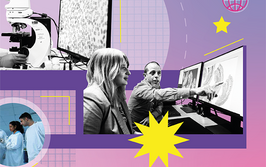A Turning Point for Digital Pathology
Will the COVID-19 pandemic turn the tide for the widespread adoption of digital pathology?

To date, the adoption of digital pathology and telepathology – one of its main use cases – has been limited. The COVID-19 pandemic, however, has emphasized the need for pathologists to conduct their work remotely due to social distancing and stay-at-home restrictions. Digital evaluation of slides has already been proven safe and effective, but the expense, altered workflows, and ergonomic changes required for implementation have not previously justified its clinical use. The current situation may have changed the calculus.
Although digital pathology systems have been in operation for decades, their use has largely been limited to areas not under regulatory control: research, education, rapid interpretations, and second opinion consultations. For use in primary diagnosis, the FDA requires clearance, which is both a costly and a lengthy process. Only two digital imaging systems have achieved FDA approval since 2017, which has further limited any substantial adoption. In addition, the longstanding Clinical Laboratories Improvement Amendments (CLIA) restrictions against interpretation of glass pathology slides outside CLIA-licensed facilities effectively banned pathologists from performing primary interpretations remotely. Now, COVID-19 is forcing the medical and regulatory communities to examine ways to combine the advantages of specimen digitization with the connective power of the Internet.
Hospitals have an urgent need to safeguard the health of their pathology staff while ensuring that they continue to provide quality care to patients. Keeping as many staff members as possible out of the hospital without compromising patient care has become a top priority. The College of American Pathologist’s recent report (1) emphasized this need, stating, “During the COVID-19 crisis, the requirement for pathologists to travel to work and unnecessarily expose themselves to the circulating SARS-CoV-2 virus puts them, their co-workers and their families at risk of a potentially deadly illness and puts patients at risk for delayed care…” Additionally, the Department of Health and Human Services’ Centers for Medicare & Medicaid Services issued laboratory guidance (2) that said, “Recognizing the urgency of the public health emergency and the need to promote innovative uses of technology to increase capacity in order to avoid exposure risks to health care providers, patients, and the community, we are exercising enforcement discretion to ensure pathologists may review pathology slides remotely…”
Even as the rate of COVID-19 infections tapers off in many states, medical centers are preparing for possible secondary surges. They are actively seeking safe and effective systems to allow their doctors to remotely access caseloads, perform work, conduct consultations with colleagues, and report diagnoses without having to enter the hospital.
This shift in regulatory oversight will likely be a turning point for the widespread adoption of digital pathology. As in other medical specialties, the pandemic is forcing moves toward telehealth – and both patients and caregivers are finding new efficiencies and benefits as a result. These improvements across medicine will not be lost on laboratory administrators. The ability to continue anatomic pathology diagnostic work from a remote location could make a shift in practice patterns inevitable. After the crisis has subsided, the advantages of telehealth in pathology – and other fields – will remain. Having become more familiar to practitioners and regulators, digital pathology practice will move more toward the mainstream.
Of course, laboratories will have to show that they can effectively deploy, validate, and document proper digital and telehealth procedures to ensure safe and effective delivery of these services. But with the current emergency use case so well documented, the time for advancing this technology is now. As a byproduct, increasing use will boost research into streamlining workflow and ergonomic issues that may present stumbling blocks. As adoption expands, regulatory bodies may find it increasingly difficult to reimpose restrictions and industry will find that obtaining approvals is a cost-effective solution to further market penetrance.
The COVID-19 pandemic has been a tragedy in human and economic terms, but it has highlighted new ways of delivering quality health care in a constrained society. Digital pathology has waited outside mainstream practice for many years – but now, with an unmistakeable need for remote diagnostic work, it’s time to make the move to digital.
- College of American Pathologists, “COVID19 – Remote Sign-Out Guidance” (2020). Available at: capatholo.gy/3ghf4Wu.
- Centers for Medicare & Medicaid Services, “Clinical Laboratory Improvement Amendments (CLIA) Laboratory Guidance During COVID-19 Public Health Emergency” (2020). Available at: go.cms.gov/2LGD2wh.
Chief Medical Officer at Corista, Concord, Massachusetts, USA.
Chief Medical Scientist and Pathologist at Corista, Concord, Massachusetts, USA.




















